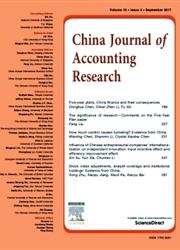Ancient notching or tokening as bookkeeping – Evidence from wood slips in China during 217–210 BCE
IF 4
Q2 BUSINESS, FINANCE
引用次数: 0
Abstract
We examine Qin Dynasty (221 to 207 BCE) wood bookkeeping slips from 217 to 210 BCE unearthed in Hunan province, China. While purely written slips were unearthed before, these slips are unique in that they contain written records of details of transactions as well as notches on their sides that represent the quantities of money or measures of commodities involved. Scholars have speculated that ancient engraving, notching or tokening before the development of written language could be bookkeeping/accounting. We show a form of bookkeeping combining notching with written records that emerged at a point in Chinese history where a region saw a temporary dip in local literacy. Notching reappeared to compensate for the loss in literacy to prevent fraud and reduce bookkeepers’ risk of being accused of fraud. This form of dual-method bookkeeping adds credence to the conjecture that prehistorical, pre-language notching, engraving or tokening was likely bookkeeping/accounting.
作为簿记的古代刻痕或标记——来自公元前217-210年中国木条的证据
我们研究了在中国湖南省出土的秦朝(公元前221年至公元前207年)公元前217年至公元前210年的木记账簿。虽然以前出土过纯文字的纸条,但这些纸条的独特之处在于,它们包含了交易细节的文字记录,以及侧面代表所涉及的货币数量或商品尺寸的缺口。学者们推测,在书面语言发展之前的古代雕刻、刻痕或标记可能是簿记/会计。我们展示了一种结合了刻痕和书面记录的簿记形式,它出现在中国历史上的某个时期,当时一个地区的当地文化水平暂时下降。缺口重新出现,以弥补文盲的损失,以防止欺诈,并降低簿记员被指控欺诈的风险。这种形式的双方法簿记增加了史前,语言之前的刻痕,雕刻或标记可能是簿记/会计的猜测的可信度。
本文章由计算机程序翻译,如有差异,请以英文原文为准。
求助全文
约1分钟内获得全文
求助全文
来源期刊

China Journal of Accounting Research
BUSINESS, FINANCE-
CiteScore
4.70
自引率
0.00%
发文量
295
审稿时长
15 weeks
期刊介绍:
The focus of the China Journal of Accounting Research is to publish theoretical and empirical research papers that use contemporary research methodologies to investigate issues about accounting, corporate finance, auditing and corporate governance in the Greater China region, countries related to the Belt and Road Initiative, and other emerging and developed markets. The Journal encourages the applications of economic and sociological theories to analyze and explain accounting issues within the legal and institutional framework, and to explore accounting issues under different capital markets accurately and succinctly. The published research articles of the Journal will enable scholars to extract relevant issues about accounting, corporate finance, auditing and corporate governance related to the capital markets and institutional environment.
 求助内容:
求助内容: 应助结果提醒方式:
应助结果提醒方式:


